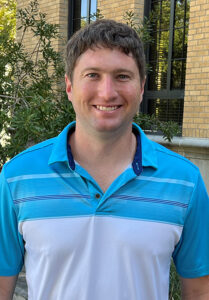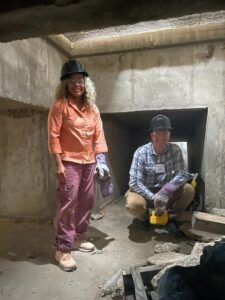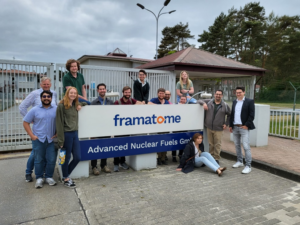Radiation Portal Monitors are important tools in the effort to prevent the smuggling of radioactive materials. By scanning vehicles, cargo, and even individuals, radiation portal monitors can swiftly detect and alert authorities to potentially dangerous materials, thereby enhancing national security and preventing the unauthorized transportation of hazardous items. These systems, typically installed at strategic points of entry, utilize large-volume scintillator detectors.

Major William “Billy” Schmidt, an active-duty officer in the United States Army utilizing the Army’s Advance Civil Schooling program, recently graduated with a Master of Science degree in nuclear engineering with a specialization in nuclear nonproliferation from Texas A&M University. His research, conducted under the guidance of Center of Nuclear Security Science and Policy Initiatives (NSSPI) Interim Director Dr. Marianno, explored the efficacy of using Silicon Photomultipliers (SiPMs) on large-volume polyvinyl toluene (PVT) scintillator detectors, aiming to enhance the technology used in portal monitors used for detecting the smuggling of radioactive materials.
“My research’s objective was to determine if Silicon Photomultipliers, a relatively new photomultiplication technology, can be used on large-volume scintillators similar to technology used at ports, railheads, and border crossings to detect radiation and deter smuggling,” Schmidt explained.
Schmidt’s work involved extensive experimentation to determine if SiPMs could serve as a superior alternative to the traditionally used Photomultiplier Tubes (PMTs). His research focused on comparing the detection efficiencies of SiPMs and PVTs on plastic scintillators with an unprecedented scintillation volume of 864 cubic inches.

According to Schmidt, radiation detector manufacturers have been interested in exploring the feasibility of using SiPMs because they offer some advantages over traditional PMTs. “They are less affected by magnetic interference, they can be made more compact and rugged, they can be more cost-effective per unit, and they require a lower power load to operate. Their effective implementation into large-volume scintillation technology could augment radiation and nuclear security by making radiation detection more cost-efficient and effective,” he explained.
Ultimately, however, the results of his study did not suggest that SiPMs were an optimal substitute for PMTs on large-volume plastic scintillators, though further research is needed to prove this conclusively. Both SiPM arrays he tested were outperformed by the scintillator’s PMT in terms of total counts and source-to-background ratio. His research did uncover one advantage offered by SiPM arrays over PMTs: an array can observe radiation “hot spots” along the length of a panel, while a PMT cannot.
Before pursuing his graduate studies at Texas A&M, Schmidt completed his undergraduate education at the United States Military Academy (USMA), where he majored in Physics and minored in Nuclear Technology and Policy Studies, a minor offered for the first time during his tenure. Schmidt takes pride in being the first USMA graduate to complete this minor. He served as an Engineer officer in the United States Army for nine years before joining NSSPI.

Reflecting on his experiences as a NSSPI student, Schmidt highlighted his participation in the International Nuclear Facilities Experience (INFE) to Europe in 2023. “My favorite NSSPI experience was the INFE to Europe. I got to see in person how some of the world’s most professionally run nuclear facilities prevent the loss of material that could be used by nefarious actors. I also got to experience an amazing cultural enrichment trip, as we visited five countries that I had never visited before,” Schmidt shared. He says the trip also provided valuable networking opportunities with fellow nuclear engineering students from prestigious universities across the United States.
Schmidt is married to the love of his life, Megan. Together they have three children and another on the way. After graduation, he will return to the USMA at West Point to serve as an instructor in the Department of Physics and Nuclear Engineering, affectionately known as the House of PaNE.